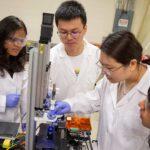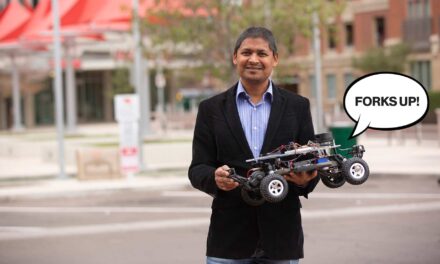
ASU transportation study supports expanded autonomous vehicle use

Above: The Federal Transit Administration has released a report about a unique mobility-on-demand service demonstration conducted by Valley Metro and Waymo. The results, authored by researchers in the Ira A. Fulton Schools of Engineering and the School for the Future of Innovation in Society, highlight significant passenger enthusiasm for autonomous vehicles. Photo courtesy of Valley Metro
A new study conducted by Arizona State University reveals public enthusiasm for greater use of autonomous vehicles, or AVs. Participants in a six-month experiment among older and disabled residents in the Phoenix metro area said they felt AV services were safe, convenient and even preferable to traditional taxis or rideshare options.
The positive results are part of a report authored by transportation experts from the Ira A. Fulton Schools of Engineering and the School for the Future of Innovation in Society at ASU. The work was sponsored by the Federal Transit Administration and conducted for the Valley Metro Regional Public Transportation Authority of greater Phoenix, in partnership with the Waymo autonomous driving technology company.
“This pilot study is unique in that it was the first one to deploy a true AV-based mobility-on-demand service for members of the public to use for their regular daily trips,” says Ram Pendyala, a professor of civil and environmental engineering at the Fulton Schools and director of the Center for Teaching Old Models New Tricks, or TOMNET, a multi-university research consortium sponsored by the U.S. Department of Transportation. “Participants could summon rides with a smartphone app, just like they would for Uber or Lyft, and take Waymo AV rides to work, shopping, dining and more.”
The experiment operated between September 2019 and March 2020 in a 100-square-mile area encompassing parts of Chandler, Mesa and Tempe, Arizona. Participating passengers were registered users of Valley Metro’s RideChoice program, a subsidized taxi or ride-hailing service for paratransit-certified people under the Americans with Disabilities Act, or ADA, and for people aged 65 and over living in greater Phoenix.
In addition to using AV transport for more than 1,100 journeys that averaged about five miles and 10 minutes, passengers completed surveys to offer their perceptions of safety, convenience, comfort and other factors in three stages: prior to the introduction of the AV service, during the operation of the service and after the experiment was completed.
The project goal was to better understand whether autonomous vehicles can fit within a community transit and mobility program, and the results indicate the answer is a resounding yes. Data show a majority of participants used the AV service to engage in more activities outside of the home than they typically would using conventional ride services. Three-quarters of passengers also said they would be comfortable riding alone in an AV, meaning without one of the human safety drivers who were stationed in the Waymo cars during the experiment.
“It is exciting to see how well autonomous vehicles were accepted as a viable travel solution for seniors and persons with disabilities,” says Jon Edwards, Valley Metro board chair and Peoria councilmember. “With a growing demand for affordable transportation, we are on the brink of a new era.”
Nicole Gavel, head of business development and strategic partnerships for Waymo, adds, “The insights gained through this first-of-its-kind partnership support developing a product and service that holds the promise of enabling mobility for all, offering a new kind of freedom for individuals to go where they want, when they want.”
Luke Tate, the managing director of ASU’s Office of Applied Innovation and the person who initiated the research support for the experiment, agrees that such positive results point to opportunities for greater social equity.
“As the operational cost curve of autonomous vehicles bends downward, and their usage becomes more widespread, municipal subsidy of AV use may be key to unlocking point-to-point mobility for low-income and mobility-limited citizens, opening a world of new educational, economic and other opportunities,” Tate says. “Sometimes getting a ride when you need it may make the difference between losing your job or not, getting to a long-sought medical appointment or not, or other serious consequences that never occur to folks with reliable transportation.”
Thad Miller, who served as an associate professor in the School for the Future of Innovation in Society until Fall 2020, conducted focus groups with study participants as well as with transportation planners and policy makers in the region. The focus group conversations consistently revealed that passengers would like to see AVs deployed on a wider scale, and that transportation professionals are eager for more studies.
Consequently, Pendyala says he hopes the results will inspire more AV-based experiments — locally, nationally and even globally.
“AV technology is evolving rapidly and different types of technologies and use cases are being developed,” says Pendyala, who also directs the School of Sustainable Engineering and the Built Environment, one of the seven Fulton Schools. “From Waymo-type AV ride services to AV buses and shuttles to AV-based freight and trucking technology, there are many possible avenues for AVs to potentially find their way into our mobility landscape.”
In addition to Pendyala, who was the study’s principal investigator, the report’s authors include Miller, Research Professor Peter Stopher, Postdoctoral Research Associate Devon McAslan, Graduate Research Associate Tassio Magassy and Graduate Student Assistant Farah Arevalo.
Full details about “An Evaluation of the Valley Metro-Waymo Automated Vehicle RideChoice Mobility-on-Demand Demonstration” are available from the Federal Transit Administration.



































